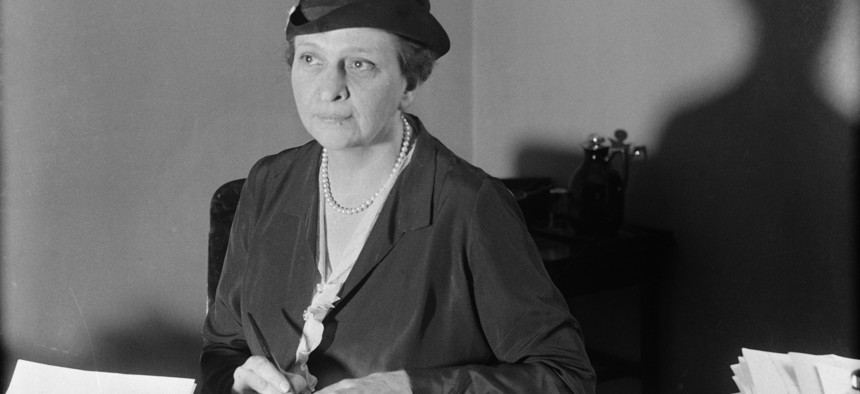4 Women Who Shaped Modern Retirement
Stories of pioneers in creating the federal government’s retirement safety net, and reaping its benefits.
Because this is Women’s History Month, I’d like to highlight the stories of four women who had an impact on the development of retirement benefits provided by the federal government. They are: Frances Perkins, Labor secretary in the Franklin Roosevelt administration; Ida Mae Fuller, the first recipient of monthly Social Security benefits; Betty Villemarette, a CIA employee who was instrumental in securing benefits for former federal spouses; and Millie Parsons, a longtime FBI employee who set an accumulated sick leave record.
Here are their stories:
Frances Perkins
During Franklin D. Roosevelt’s Administration, Perkins became the first woman to hold a cabinet position when she served as Labor secretary. In this role, she pushed for a series of workplace reforms, including a minimum wage and unemployment compensation system. In 1934, she chaired the President’s Committee on Economic Security, which eventually led to the passage of the 1935 Social Security Act. Later, Perkins served at the U.S. Civil Service Commission.
At the age of 80, during a speech to Social Security Administration employees, she said, "we have to admit that no matter how much fine reasoning there was about the old-age insurance system and the unemployment insurance prospects, no matter how many people were studying it, or how many committees had ideas on the subject, or how many college professors had written theses on the subject—and there were an awful lot of them—the real roots of the Social Security Act were in the Great Depression of 1929. Nothing else would have bumped the American people into a Social Security system except something so shocking, so terrifying, as that depression.”
Ida Mae Fuller
Fuller certainly got a great return on her contributions to the Social Security system. She worked as a legal secretary in Vermont, and started paying into Social Security when the government began collecting payroll taxes in 1937. She contributed for three years before retiring. At that time, the Social Security tax rate was 1% of salary by both the employee and the employer, on the employee’s first $3,000 of earnings. The rate would go up in four steps, so by 1949 it was 3% each on the first $3,000 of salary.
Before she retired, Fuller paid $24.75 in payroll taxes on total earnings of $24,750 from June 1937 to September 1939. She then received a benefit that started out at $22.54 per month. Fuller lived to be 100 years old, and over her lifetime received a total of nearly $23,000 in benefit payments.
A trip to the Social Security office in Rutland, Vermont, at the end of Fuller’s career definitely paid off. "It wasn't that I expected anything, mind you,” she later said, “but I knew I'd been paying for something called Social Security and I wanted to ask the people in Rutland about it."
Betty Villemarette
Villemarette didn’t start out as an employee of the intelligence community, but as a spouse and then a former spouse of an intelligence officer. She accompanied her husband on dangerous assignments overseas. On one occasion, she disarmed one of the guards who was supposed to be providing protection to her family in Ethiopia after he shot out the windows of their home.
In the early 1970s, Villemarette’s marriage ended and she found herself in dire financial straits.There were no laws at that time to provide former spouses with income, retirement or health care benefits. After her divorce, Betty started her own CIA career, and worked over the next 10 years to secure benefits for former spouses of federal employees. She testified before a congressional committee in support of the legislation that would become the 1984 Civil Service Spouse Equity Act. Former CIA Director Leon Panetta called Villemarette “a tireless advocate for agency employees and families. Her hard work and dedication did much to improve the quality of life for our officers and their loved ones.”
Millie Parsons
Parsons set a sick leave record that would be very difficult to beat. She was the longest continuously serving employee in the history of the FBI at the time of her death in 2012. Parsons began her career in 1939 under J. Edgar Hoover and retired at age 88 in 2002. She served under a total of six FBI directors and had 30 different supervisors at the agency’s Washington field office. She spent her entire career there, first as a clerk typist and later as front office secretary.
By the time Parsons retired, she had served for 62 years, nine months and two days, and had amassed thousands of hours of sick leave credit, because she virtually never called in sick. According to a Washington Post story written at the time of her retirement, Parsons' sick-free record became a matter of legend at the FBI.
Since federal employees earn 2,080 hours of sick leave every 20 years, after 62 years of service Parsons could have earned more than three years of such leave. But when she was first hired, there wasn’t a formal sick leave system.
Even with her long career, Parsons was able to enjoy retirement for more than 10 years before she died just shy of turning 100 years old.






